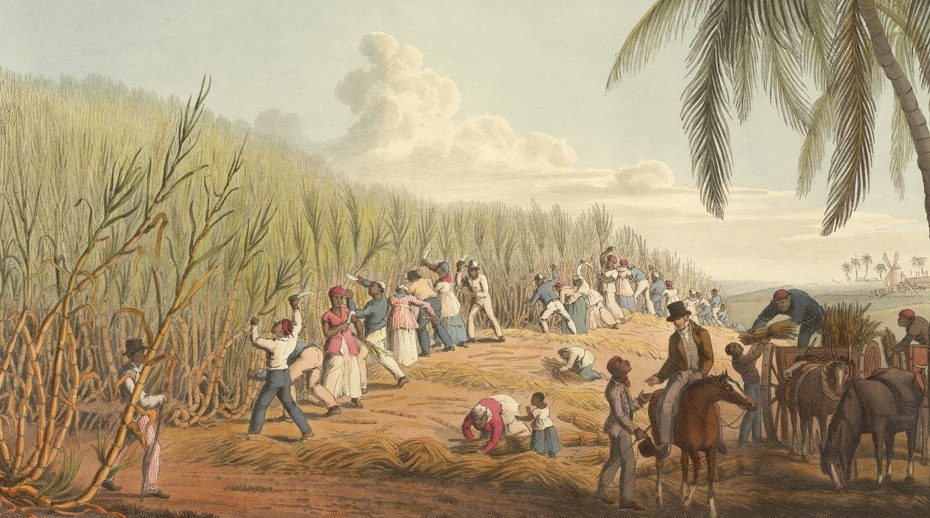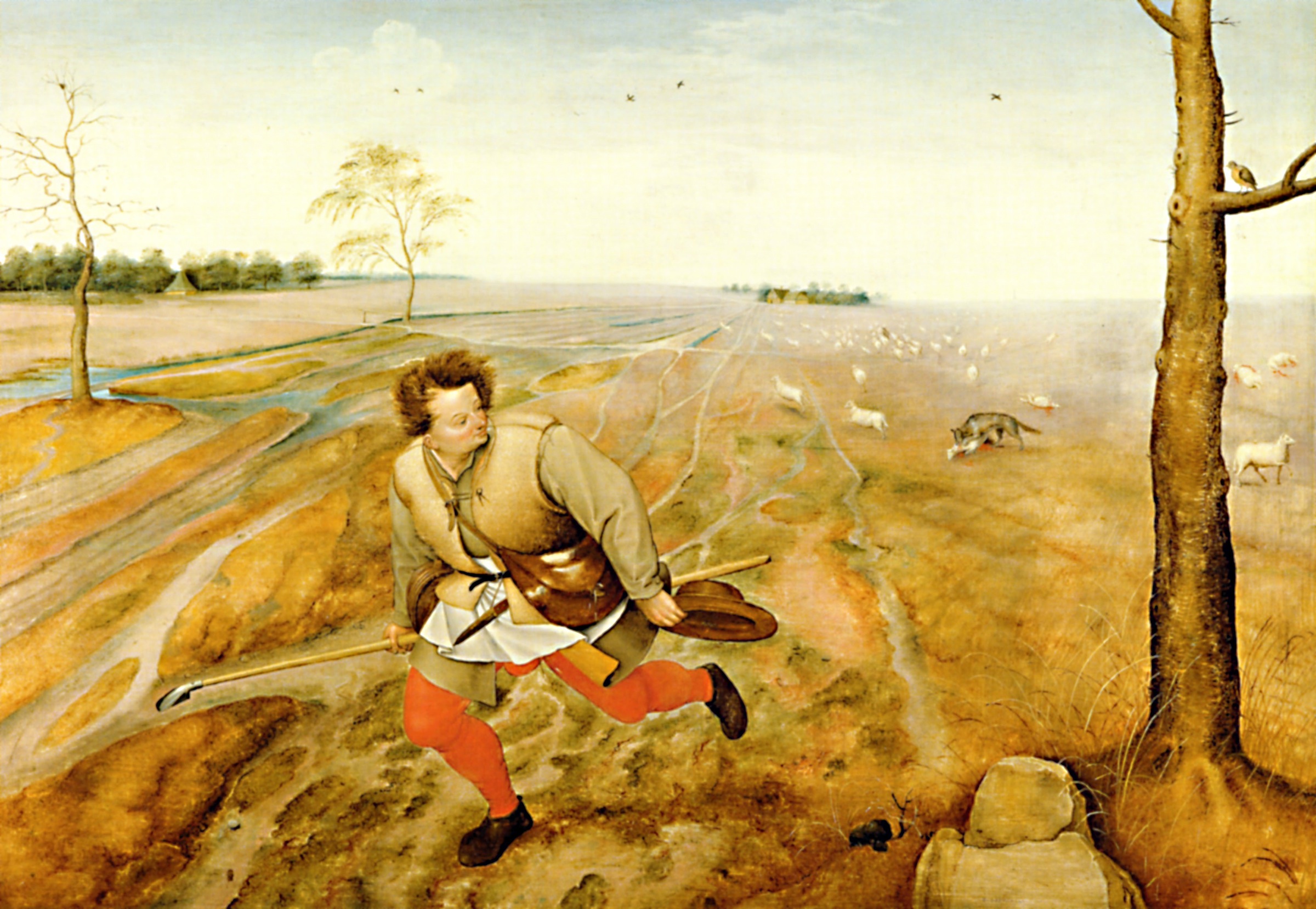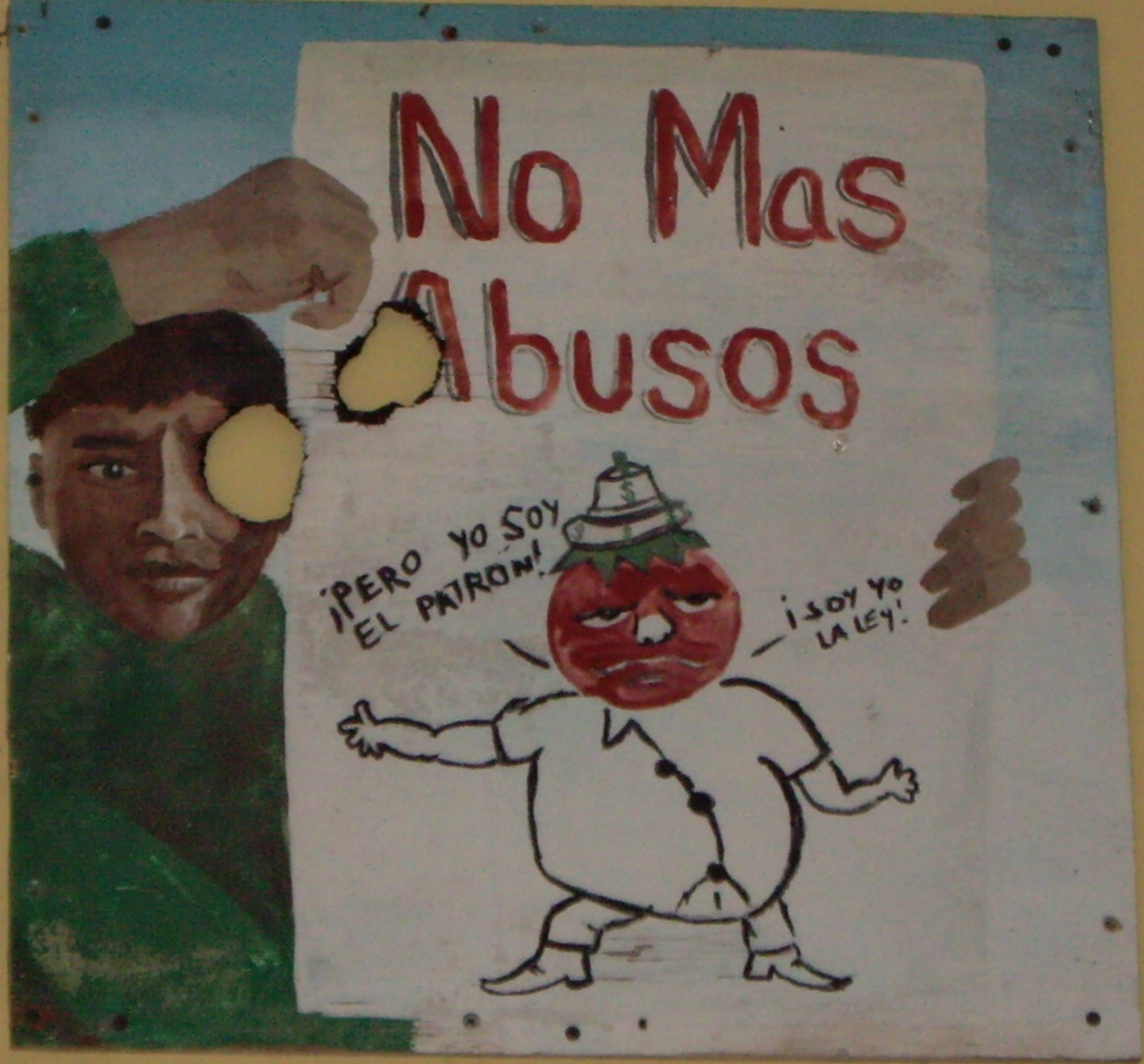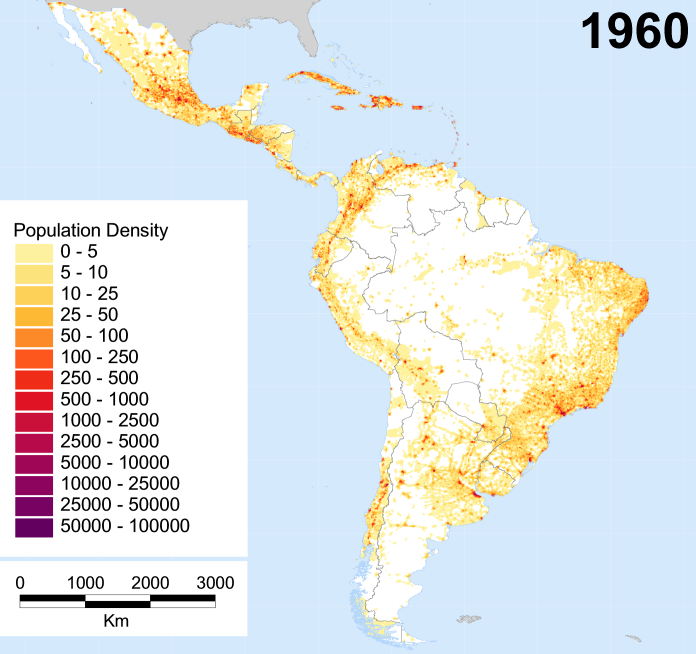 Sydney Mintz
Sydney Mintz 
Sweetness and Power: the Place of Sugar in Modern History
1986.
Start | Question | Commodities | Chapters | Introduction | Foods vs. diets | Notes | Vocabulary
Saccharum Officinarum Linnaeus
The genus Saccharum was first described by Linnaeus (1753) in his book Species Plantarum.
Sugar cane harvesting in the West Indies, c. 1830s.
What defines a true revolution ?
? And can it be that taste, fashion, or style are more convincing, if not more lasting than politics?
A collateral and pivotal question.
"What commodities are, and what commodities mean, would thereafter be forever different. And for that same reason, what persons are, and what being a person means, changed accordingly. In understanding the relationship between commodity and person, we unearth a new history of ourselves."
p. 214.
Food | Production | Consumption | Power | Eating & Being
How? | Facts | Conundrums | Capitalism | Comment
- Food, Sociality, and Sugar, "Sweetness is a taste --what Hobbes called a 'Quality'--"
- Production,"I... focus on the possessions that supplied the UK with sugar, molasses, & rum.
- Consumption, "a discussion in terms of what people did and thought...."
- Power, "I try to say something about ...circumstance, conjuncture, and cause."
- Eating and Being, "Social phenomena are by their nature historical."
Introduction
![]()
"Since sugar seems to satisfy a particular desire (it seems, in
doing so to awaken that desire yet anew), one needs to understand just
what makes demand work: how and why it increases under what conditions."
European roots are "obscure & enigmatic" the history of sugar consumption in Britain from 1650 -1900
"A single source of satisfaction – sucrose extracted from sugar cane – for what appears to be widespread, perhaps even universal, human liking for sweetness became established in European taste preferences at a time when European power, military might, and economic initiative were transforming the world."
xxv
"Because anthropology is concerned with how people stubbornly maintain past practices, even when under strong negative pressures, but repudiate other behaviors quite readily in order to act differently , these materials throw light on the historical circumstances.... different from a historians'."
xxvi
"I don't think meanings inhere in substances naturally or inevitably. Rather, I believe that meaning arises out of use, as people use substances in social relationships.
Outside forces often determine what is available to be endowed with meaning"
xxxix
Chapters | Food | Production | Consumption | Power | Eating & Being
Food, Sociability, and Sugar
How? | Facts | Conundrums | Capitalism | Comment
"taxonomies of taste"
“food and eating are foci of habit, taste and deep feeling...” as old as our species.
p. 3.“Nutrition… is more fundamental than sex.” Audrey Richards, biological anthropologist.
“Food differences are close to the center of their [people's] self-definition. . . .”
"In 1000 AD, few Europeans knew of the existence of sucrose, or cane sugar. . . . by 1650, in England the nobility and the wealthy had become inveterate sugar eaters. . . . by 1800 sugar had become a necessity – albeit a costly and rare one – in the diet of every English person; by 1900, it was supplying nearly one-fifth of the calories in the English diet."
"How and why did this happen?"
"The sources of sugar involve those tropical and subtropical islands that were transformed into British colonies, and so we must examine the relationships between such colonies and the motherland, also the areas that produced no sugar but the tea with which it was drunk, and the people who were enslaved in order to produce it."
6.
"this costly food?"
"we must understand how, in the creation of an entirely new economic system, strange and foreign luxuries,...could so swiftly become part of the crucial social center of British daily life."
7.
"Sugar has been associated during its history with slavery, in the colonies, with meat in flavoring or concealing taste; with fruit in preserving; with honey as a substitute and rival"
7-8.
"the character of the English diet, ..is relevant, were struggling to stabilize their diets around adequate quantities of starch consumption."
13
"the importance of sweetness in English taste preferences grew overtime, and was not characteristic before the eighteenth century."
18
"How widely attitudes toward sweetness vary,"
"it is the borderline between our human likeness for sweetness and the supposed English 'sweet tooth' that I hope to illuminate..."
18
cultivating yams for subsistence, a resident of the British West Indies.
How? | Facts | Conundrums | Capitalism | Comment
Food | Production | Consumption | Power | Eating & Being
Production
" . . .it must be remembered that the sugar eater's loss was the sugar planter's gain."
p. 56.
"A plant food manufactured photosynthetically from carbon dioxide and water, [fructose] sucrose is thus a fundamental feature of the chemical architecture of living things."
"The sugar cane was first domesticated in New Guinea, and very anciently."
19
"sugar must be crystallized from liquid. What we call sugar is the end product of an ancient, complex, and difficult process."
21.
"The intrinsic nature of sugar cane fundamentally affected its cultivation and processes."
"The practice of crushing comminuting the cane fibers so their liquid content can be extracted . . . can be accomplished in a number of different ways."
"Heating the liquid containing the sucrose causes evaporation and the resulting in sucrose concentration. As the liquid becomes supersaturated, crystals begin to appear."
- land consuming,
- water dependent,
- labor intensive,
- costly to extract, store, ship.
- gives rise to commercial exchange because it keeps.
21.
"While cooling and crystallizing, low-grade massecuites leave 'final' or 'blackstrap' molasses. The molasses, or treacle, cannot be crystallized further by conventional methods."
pp. 21-22.
Supplemental material pertinent to production:
Extraction of Cane-juice.—Cane-juice is generally extracted from the stems by means of a sugar mill. The canes, when ripe, are cut close to the ground, stripped of their leaves, and carried in bundles to the mill-house, where they are twice subjected to pressure between iron rollers, placed either vertically or horizontally. The residue of the canes which have been thus crushed and deprived of their juice is called megass.
Other methods of extracting the cane juice have been suggested.
The hydraulic press has been introduced into Jamaica and St. Vincent's. By Michiel's patent it is proposed to macerate thin slices of the cane in a mixture of lime and water, so as to coagulate the albuminous matters but to extract the sugar.
It had also been proposed to extract the sugar in Europe from the canes imported in the dried state.
Notes: [For details, see Dr. Evans's Sugar-Planters Manual, 1847.]
How? | Facts | Conundrums | Capitalism | Comment
"The Arab expansion westward marked a turning point in the European experience with sugar."
500 A.D. definitive evidence for sugar making molasses in a Hindu religious text.
627, Persians in possession of East Indian sugar & discovered by the Byzantine invaders.
710, sugar is planted in Egypt.
711, Arabs in Spain.
732-759, Arab retreat from the Provence into Spain.
996, sugar in Venice.
1291, with the fall of Acre, the Knights of Malta bring sugar to Sicily in the west.
1450, Madeira is the largest producer of sugar cane after Spanish introduced it to the island.
1573, the German botanist Leonhard Raulwolf calls sugar addictive.
1580, a decline in Sicilian production of sugar cane replaced by Brazil & the West Indies.23-24, & 31.
"The spread of sugar cane and the technology required for its cultivation and conversion encountered obstacles – mostly rain and seasonal temperature fluctuations. As we have seen, sugar cane is a tropical and subtropical crop with a growing season that may be in excess of twelve months; it requires large amounts of water and labor. Though it can flourish without irrigation, it does far better (and increases its sugar content) when it is watered regularly. . . ."
p. 25.
"Certain facts stand out in the history of sugar between early decades of the seventeenth century (1600s), when the British, Dutch, and French established Caribbean plantations and the middle of the nineteenth century, by which time Cuba and Brazil were the major centers of New World production.”
36
“Over this long period, sugar production grew steadily, as more Westerners consumed sugar and each consumer used it more heavily. Yet technological changes in the field, in grinding and even in refining itself were relatively minor.”
“Generally speaking, the enlarged market for sugar was satisfied by a steady extension of production rather than by sharp increases in yield per acre of land or ton of cane, or in productivity per worker.”
Page. 36.
“…before the seventeenth century there was a lively awareness of the desirability of sugar.”
Evidence from i.e. the failures of Waiapoco, Guiana, 1595, Bermuda, 1600s, and Jamestown Virginia, 1619. “enslaved Africans.”
“The turning point for British sugar was the settlement of Barbados in 1627, an island Britain claimed after Captain John Powell’s landing there in 1625, while returning to Europe from Brazil.”
Not until 1655 with the British invasion of Jamaica, does the amount of sugar become commercially notable.
“after 1655 and until the mid nineteenth century, the sugar supply of the English people would be provided substantially within the skein of the empire.”
… imperial laws were passed to control the flow of such goods, and of the goods for which they were exchanged.”Page 37.
“At the consumption end, changes were both numerous and diverse. Sugar steadily changes from being a specialized—medicinal, condiment, ritual, or display commodity into an ever more common food.
Pages, 36-37.
“This insertion of an essentially new product within popular European tastes and preferences was irreversible, though the cost of the sugar at times certainly braked consumption.”
Page, 37.
How? | Facts | Conundrums | Capitalism | Comment
The relative costs of the sugar trade to Britain's taxpayers and its economic impacts on society, show that the trade was subsidized by Britain's tax payers.
"Thomas & McCloskey" write
"It is obvious that the colonial plantations and farms were privately profitable to their owners."
56.
"The maturing of a plantation system based on slavery in the Caribbean region came with, and was greatly preconditioned on, the development of powerful commercial and military navies in western Europe. "
"It meant the funneling of great quantities of commodities (rum . . . ) into Africa for the purchase of slaves – an investment that did nothing for Africa's development but only stimulated more slave raiding. It led to enormous outputs of wealth in the metropolises to garrison the colonies and to ensure the coercion and control of slaves."
"To maintain the mercantilist premises of the system that the colonies buy from and sell to the motherland only, and that trade be carried only in the motherland's ships – was expensive for each national system, though of course certain groups inside of each system profited greatly from it . . ." . over four centuries"
58.
"The English connection between sugar production and sugar consumption was welded in the seventeenth century, when Britain acquired Barbados, Jamaica, and other sugar islands, vastly expanded her trade in African slaves, made inroads into the Portuguese domination of the Continental sugar trade, and first began to build a broad internal consumer market."
p. 61.
"vast new sources of demand were being opened in England and Europe – demand created by a sudden cheapness when these English plantation goods brought a collapse in prices which introduced the middle classes and the poor to novel habits of consumption...'
p. 63.
"This change was seen perhaps most dramatically in the case of tobacco. A luxury at the end of the sixteenth century, in a hundred years it had become 'the general solace of all classes.' the case with sugar was similar."
p. 64.
"that the single most important nutritional datum on the British people was their fivefold increase in sugar consumption. . . . no other food in world history has had comparable performance."
p. 73.
Food | Production | Consumption | Power | Eating & Being
Consumption
twelfth century is the earliest mention of sugar in England
"Most basic foods did not move far from where they were produced."
"All other foods, including meats, diary products, vegetables and fruits, were subsidiary to grains. It was poverty of resources..."
"grain was the core of the diet of the poor."
75
The 1596 famine & Sir Hugh Platt's advice "boil your beans, pease, beechmast. . ."
1595 - 97, poor harvests lead to lean years in England.
76-77
- The famine of 1595 marked the end of the Croquant uprising.
- One major riot in 1594-1595 was centred in the province of Upper Austria
- Upper Austria is referred to as Oberösterreich. ...
- On November 13th 1595, a peasant force 4,000 men strong defeated Imperial forces of the Holy Roman Empire
- The peasant revolt, which in 1596 extended into Lower Austria,
- Upper Austria, 'beyond the river Enns'
- Finland a peasant revolt occurred in 1596–97
"From the first known introduction of sugar to England until the late seventeenth century, when it became the desired good – consumed frequently by the wealthy, and soon to be afforded by many who would forego important quantities of other foods in order to have it – we are dealing with a limited agricultural production and a narrow diet."
77
"There is no comparable story for either coffee, or chocolate; nor is any such monopoly to be found in the history of West Indian sugar, where different sugar colonies vied with one another. But the relationship among these four products – together with rum (molasses) and tobacco – was intimate and entangled. Tea won out. . . ."
p. 113.
The nineteenth century consumption figures for sugar imports in Great Britain.
Food | Production | Consumption | Power | Eating & Being
How? | Facts | Conundrums | Capitalism | Comment
Power
"Over the course of less than two centuries, a nation most of whose citizens formerly subsisted almost exclusively on foods produced within its borders had become a prodigious consumer of imported goods."
"Usually these foods were new to those who consumed them, supplanting more familiar items ...gradually transformed from exotic treats into ordinary everyday consumables."
"As these changes took place, the foods acquired new meanings, but those meanings – what the foods meant to people, and what people signaled by consuming them – were associated with social differences of all sorts, including those of age, gender, class, and occupation. "
151
• intensification.
• extensification.
"our capacity to symbolize, to endow anything with meaning and then act in terms of that meaning, is similarly universal and intrinsic to our nature [character]
153-54
"Both substances [sugar and honey] were associated with happiness and well-being, with elevation of mood, and often with sexuality. The quality of sweetness, so important in the structure of human taste and preference, was applied to personality, to generous acts, to music, to poetry."
"The Indo-European root swad is the ultimate source of both 'sweet' and 'persuade' ; in contemporary English 'sugared' or 'honeyed' speech has been supplemented by 'syrupy tones' and 'sweet talking.'
p. 155.
"its cumulative value to crown and capital alike was enormous."
156
How? | Facts | Conundrums | Capitalism | Comment
"The West Indian plantations had been profitable from the first because of the desire for sugar (and like products) in Europe; ...English internal demand eventually overshadowed almost completely the re-export trade. Sugar, then, was the cornerstone of British West Indian slavery and the slave trade, and the enslaved Africans who produced the sugar were linked in clear economic relationships to the British laboring people who were learning to eat it."
176
"Sugar for a great part of our population is a stimulant, a source of immediate energy, if not inspiration, whether it is turned into alcohol or consumed raw."
"The substances transformed by British capitalism from upper-class luxuries into working class necessities are of a certain type. Like alcohol or tobacco, they provide a respite from reality, and deaden hunger pangs. Like coffee, or chocolate or tea, they provide stimulus to greater effort without providing nutrition."
"There was no conspiracy at work to wreck the nutrition of the British working class, to turn them into addicts, or ruin their teeth. But the ever-rising consumption of sugar was an artifact of interclass struggles for profit – struggles that eventuated in a world market solution for drug food, as industrial capitalism cut its protectionist losses and expanded a mass market to satisfy proletarian consumers once regarded as sinful or indolent."
"In this perspective, sugar was the ideal substance. It served to make a busy life seem less so; in the pause that refreshes, it eased, or seemed to ease, the changes back and forth from work to rest; it provided swifter sensations of fullness or satisfaction than complex carbohydrates did; it combined easily with with many other food, in some of which it was also used. And as we have seen, it was symbolically powerful, for its use could be endowed with many subsidiary meanings. No wonder the rich and powerful liked it so much, and no wonder the poor learned to love it."
186
Food | Production | Consumption | Power | Eating & Being
How? | Facts | Conundrums | Capitalism | Comment
Eating and Being
"we have already seen how sucrose, this 'favored child of capitalism'-- Fernando Ortiz' lapidary phrase-- epitomized the transition from one kind of society to another."
"The first sweetened cup of hot tea..." had "consequences"..."for upon them (kindred events) "was erected an entirely different conception of the relationship between producers and consumers, of the meaning of work, of the definition of self, of the nature of things."214
Linnaeus' (1753) book Species Plantarum.
The generic name is derived from the Greek word sakcharon, which means sugar and was duly Latinized by the author. The book described two species: Saccharum officinarum L. and S. spicatum L., which is currently classified under the genus Perotis (P. spicata (L.) T. Durand and H. Durand) (Dillon et al. 2007). The plants are perennial grasses confined to tropical and sub tropical climates.
S. officinarum has been cultivated since prehistoric times (Sreenivasan et al. 1987). It is believed that its center of origin is Polynesia and that the species was disseminated throughout Southeast Asia, where a modern center of diversity was created in Papua New Guinea and Java (Indonesia); this is the region where the majority of specimens were collected in the late 19th century (Roach and Daniels 1987). The center of origin and diversity of S. spontaneum is the more temperate regions of subtropical India. However, because S. spontaneum can be grown in a wide range of habitats and altitudes (in both tropical and temperate regions), it is currently spread over latitudes ranging from 8°S to 40°N.Notes
Saccharum officinarum - "Sugarcane is one of the most important crops in the world and Brazil accounts for 25% of worldwide production. The genus Saccharum is complex and is characterized by high polyploidy and frequent aneuploidy." (Sreenivasan et al., 1987).
Sugarcane (Saccharum officinarum L.) straw left in the field after harvest interferes with the growth of winter and summer weeds. In the past years, there has been a progressive move away from burning sugarcane straw to retaining it on the soil surface after harvest to prevent soil degradation and environmental pollution.
See: http://www.ncbi.nlm.nih.gov/pmc/articles/PMC3075403/
How? | Facts | Conundrums | Capitalism | Comment

.gif)







